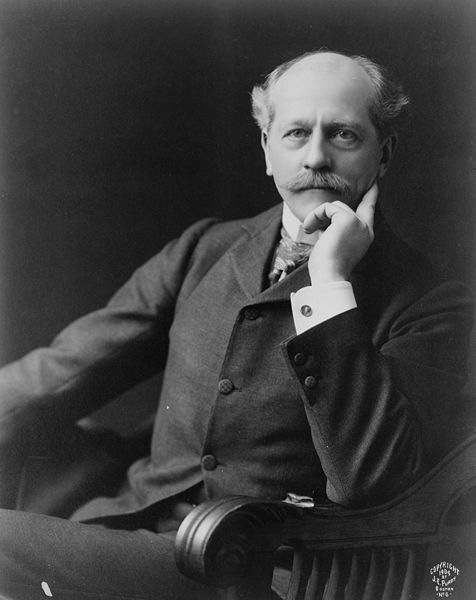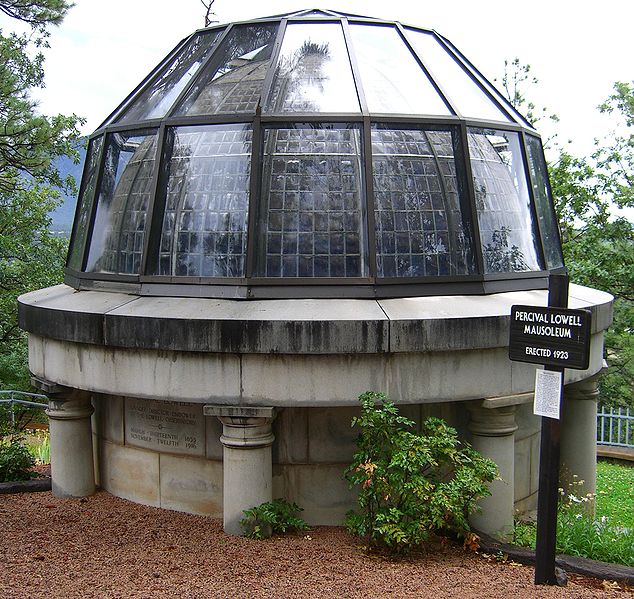<Back to Index>
- Astronomer Percival Lawrence Lowell, 1855
- Painter Maximilien Luce, 1858
- Holy Roman Emperor Joseph II, 1741
PAGE SPONSOR


Percival Lawrence Lowell (March 13, 1855 – November 12, 1916) was a businessman, author, mathematician, and astronomer who fueled speculation that there were canals on Mars, founded the Lowell Observatory in Flagstaff, Arizona, and formed the beginning of the effort that led to the discovery of Pluto 14 years after his death. The choice of the name Pluto and its symbol were partly influenced by his initials PL.
Percival Lowell, a descendant of the Boston Lowell family, was the brother of A. Lawrence, president of Harvard University, and Amy, an imagist poet, critic, and publisher.
Percival graduated from the Noble and Greenough School in 1872 and Harvard University in 1876 with distinction in mathematics. At his college graduation, he gave a speech, considered very advanced for its time, on the "Nebular Hypothesis." He was later awarded honorary degrees from Amherst College and Clark University.
In the 1880s, Lowell traveled extensively in the Far East. In August 1883, he served as a foreign secretary and counsellor for a special Korean diplomatic mission to the United States. He also spent significant periods of time in Japan, writing books on Japanese religion, psychology, and behavior. His texts are filled with observations and academic discussions of various aspects of Japanese life, including language, religious practices, economics, travel in Japan, and the development of personality. Books by Percival Lowell on the Orient include Noto (1891) and Occult Japan (1894); the latter from his third and final trip to the region. The most popular of Lowell's books on the Orient, The Soul of the Far East (1888), contains an early synthesis of some of his ideas, that in essence, postulated that human progress is a function of the qualities of individuality and imagination.
Beginning in the winter of 1893-94, using his wealth and influence, Lowell dedicated himself to the study of astronomy, founding the observatory which bears his name. For the last 23 years of his life astronomy, Lowell Observatory, and his and others' work at his observatory were the focal points of his life. He lived to be 61 years of age.
World War I very
much saddened Lowell, a dedicated pacifist. This, along with some
setbacks in his astronomical work (described below), undermined his
health and contributed to his death from a stroke on November 12, 1916. Lowell is buried on Mars Hill near his observatory. Lowell became determined to study Mars and astronomy as a full-time career after reading Camille Flammarion's La planète Mars. He was particularly interested in the canals of Mars, as drawn by Italian astronomer Giovanni Schiaparelli, who was director of the Milan Observatory. In 1894 Lowell chose Flagstaff, Arizona Territory, as
the home of his new observatory. At an altitude of over 2100 meters
(7000 feet), with few cloudy nights, and far from city lights,
Flagstaff was an excellent site for astronomical observations. This
marked the first time an observatory had been deliberately located in a
remote, elevated place for optimal seeing. For
the next fifteen years he studied Mars extensively, and made intricate
drawings of the surface markings as he perceived them. Lowell published
his views in three books: Mars (1895), Mars and Its Canals (1906), and Mars As the Abode of Life (1908).
With these writings, Lowell more than anyone else popularized the
long-held belief that these markings showed that Mars sustained
intelligent life forms. His
works include a detailed description of what he termed the 'non-natural
features' of the planet's surface, including especially a full account
of the 'canals,' single and double; the 'oases,' as he termed the dark
spots at their intersections; and the varying visibility of both,
depending partly on the Martian seasons. He theorized that an advanced
but desperate culture had built the canals to tap Mars' polar ice caps,
the last source of water on an inexorably drying planet.
While
this idea excited the public, the astronomical community was skeptical.
Many astronomers could not see these markings, and few believed that
they were as extensive as Lowell claimed. As a result, Lowell and his
observatory were largely ostracized. Although the consensus was that
some actual features did exist which would account for these markings, in
1909 the sixty-inch Mount Wilson Observatory telescope in Southern
California allowed closer observation of the structures Lowell had
interpreted as canals, and revealed irregular geological features,
probably the result of natural erosion. The existence of canal-like features would not be definitively disproved until Mariner 4 took the first close-up pictures of Mars in 1965, and Mariner 9 orbited and mapped the planet in 1972. Today, the surface markings taken to be canals are regarded as an optical illusion. Although Lowell was better known for his observations of Mars, he also drew maps of the planet Venus.
Lowell observed spoke-like features and a central dark spot, yet it is
now known that Venus' atmosphere is opaque. In an article published in Sky and Telescope in July 2003, it was suggested that in fact Lowell was observing an image of the blood vessels in his own eye. Lowell's greatest contribution to planetary studies came during the last decade of his life, which he devoted to the search for Planet X, a hypothetical planet beyond Neptune. Lowell believed that the planets Uranus and Neptune were displaced from their predicted positions by the gravity of the unseen Planet X. Lowell
started a search program in 1906 using a camera 5 inches in
aperture. The small field of view of the 42-inch reflecting telescope
rendered the instrument impractical for searching. From 1914 to 1916, a 9-inch telescope on loan from Sproul Observatory was used to search for Planet X. Although Lowell did not discover Pluto, Lowell Observatory (690) did photograph Pluto in March and April 1915. In 1930 Clyde Tombaugh, working at the Lowell Observatory, discovered Pluto near the location expected for Planet X. Partly in recognition of Lowell's efforts, a stylized P-L monogram ( Pluto's
mass could not be determined until 1978, when a satellite was
discovered. This confirmed what had been increasingly suspected:
Pluto's gravitational influence on Uranus and Neptune is negligible,
certainly not nearly enough to account for the discrepancies in their
orbits. In 2006, Pluto was reclassified as a dwarf planet by the International Astronomical Union. In addition, it is now known that the discrepancies between the predicted and observed positions of Uranus and Neptune were not caused by the gravity of an unknown planet. Rather, they were due to an erroneous value for the mass of Neptune. Voyager 2's 1989 encounter with Neptune yielded a more precise value of its mass, and the discrepancies disappear when using this value. Although
Lowell's theories of the Martian canals, of surface features on Venus,
and of Planet X are now discredited, his practice of building
observatories at the position where they would best function has been
adopted as a principle. He also established the program and setting which made the discovery of Pluto by Clyde Tombaugh possible. Craters on the Moon and on Mars have been named after him. Lowell has been described by other planetary scientists as "the most influential popularizer of planetary science in America before Carl Sagan." While
eventually disproved, Lowell's vision of the Martian canals as an
artifact of an ancient civilization making a desperate last effort to
survive had an enormous influence on the development of Science Fiction, starting with H.G. Wells' enormously influential "The War of the Worlds" which made the logical further inference that creatures from a dying planet might seek to invade Earth. The
image of the dying Mars and its ancient culture was retained, in
numerous versions and variations, in most SF works depicting Mars in
the first half of the Twentieth Century.
Also when proven to be factually mistaken, the vision of Mars derived
from his theories remains enshrined in works which remain in print and
widely read as classics of Science Fiction.
 ) — (the first two letters of the new planet's name and also Lowell's initials), was chosen as Pluto's astronomical symbol. However, it would subsequently emerge that the Planet X theory was mistaken.
) — (the first two letters of the new planet's name and also Lowell's initials), was chosen as Pluto's astronomical symbol. However, it would subsequently emerge that the Planet X theory was mistaken.